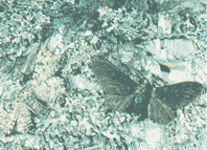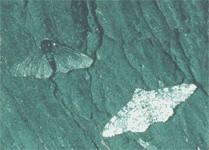Evolution
The origin of species is based on the following three facts:
1) There is variation among the members of any given species.
2) The number of newly born members of any specious tend to increase
in geometric ratio.
3) The number of mature members of any specious tend to remain fairly constant.
From these three facts, Charles Darwin in The origin of Species in 1959 concluded:
1) There is struggle for existence.
2) In this struggle mainly the fittest survive, and he called this "natural selection."
Examples
| According to Darwin, the giraffe got its long neck not by stretching but because some
giraffes were born with longer necks than their fellows, and the longer the neck, the more
chance a giraffe had of reaching food. By natural selection, the long-necked species won out.
Natural selection explained the giraffe's blotched coat just as easiliy: an animal with
blotches on its skin will blend against the sun-spotted vegettion and thus have more chance
of escaping the attention of a prowling lion. | |
  In England, it seems, the peppered moth exists in two varieties, a light and a dark.
In Darwin's time, the white variety was predominant because it was less prominently
visible against the light lichen-covered bark of the trees it frequented. It was saved
by this protective coloration, more often than were the clearly visible, dark variety,
from those animals that would feed on it. As England grew more industrialized, however,
soot killed the lichen cover and blackened the tree bark. It was then the dark variety
that was less visible against the bark and was protected. Therefore, the dark variety
became predominant--through the action of natural selection.
In 1952, the British Parliament passed laws designed to clean the air. The quantity
of soot declined, the trees regained some of their light lichen covering, and at once
the percentage of the light variety of moth began to increase. All this change is quite
predictable by evolutionary theory, and it is the mark of a successful theory that it not
only explains the present but can predict the future.
In England, it seems, the peppered moth exists in two varieties, a light and a dark.
In Darwin's time, the white variety was predominant because it was less prominently
visible against the light lichen-covered bark of the trees it frequented. It was saved
by this protective coloration, more often than were the clearly visible, dark variety,
from those animals that would feed on it. As England grew more industrialized, however,
soot killed the lichen cover and blackened the tree bark. It was then the dark variety
that was less visible against the bark and was protected. Therefore, the dark variety
became predominant--through the action of natural selection.
In 1952, the British Parliament passed laws designed to clean the air. The quantity
of soot declined, the trees regained some of their light lichen covering, and at once
the percentage of the light variety of moth began to increase. All this change is quite
predictable by evolutionary theory, and it is the mark of a successful theory that it not
only explains the present but can predict the future. | |
| Source: Isaac Asimov (1984). Asimov's New Guide To Science, Penguine Books, p. 706. | |

 In England, it seems, the peppered moth exists in two varieties, a light and a dark.
In Darwin's time, the white variety was predominant because it was less prominently
visible against the light lichen-covered bark of the trees it frequented. It was saved
by this protective coloration, more often than were the clearly visible, dark variety,
from those animals that would feed on it. As England grew more industrialized, however,
soot killed the lichen cover and blackened the tree bark. It was then the dark variety
that was less visible against the bark and was protected. Therefore, the dark variety
became predominant--through the action of natural selection.
In 1952, the British Parliament passed laws designed to clean the air. The quantity
of soot declined, the trees regained some of their light lichen covering, and at once
the percentage of the light variety of moth began to increase. All this change is quite
predictable by evolutionary theory, and it is the mark of a successful theory that it not
only explains the present but can predict the future.
In England, it seems, the peppered moth exists in two varieties, a light and a dark.
In Darwin's time, the white variety was predominant because it was less prominently
visible against the light lichen-covered bark of the trees it frequented. It was saved
by this protective coloration, more often than were the clearly visible, dark variety,
from those animals that would feed on it. As England grew more industrialized, however,
soot killed the lichen cover and blackened the tree bark. It was then the dark variety
that was less visible against the bark and was protected. Therefore, the dark variety
became predominant--through the action of natural selection.
In 1952, the British Parliament passed laws designed to clean the air. The quantity
of soot declined, the trees regained some of their light lichen covering, and at once
the percentage of the light variety of moth began to increase. All this change is quite
predictable by evolutionary theory, and it is the mark of a successful theory that it not
only explains the present but can predict the future.